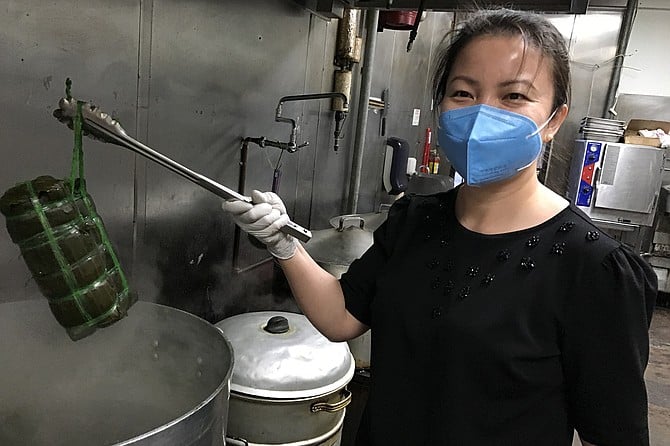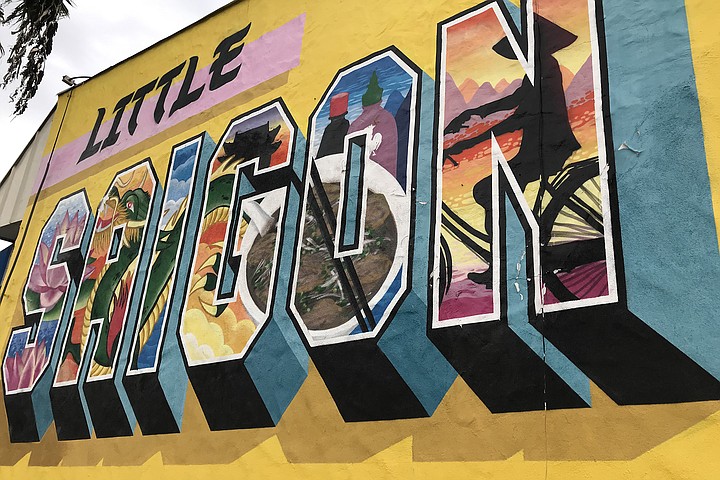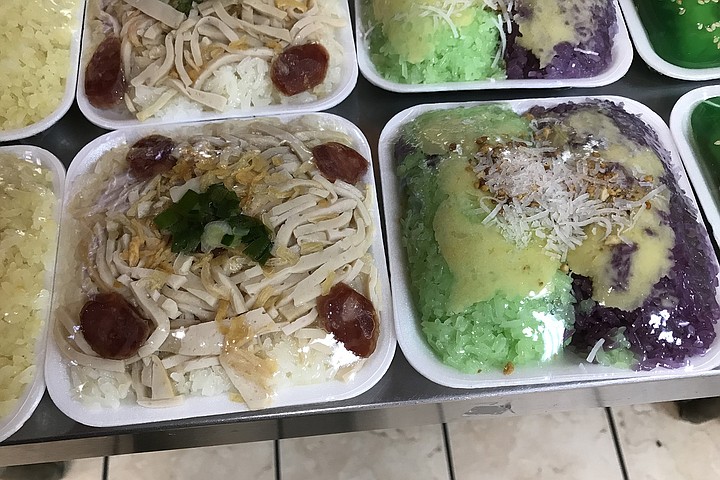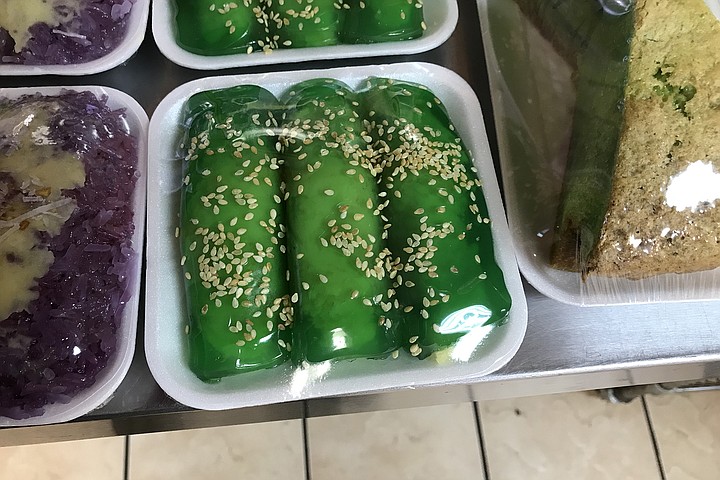 Facebook
Facebook
 X
X
 Instagram
Instagram
 TikTok
TikTok
 Youtube
Youtube

Just been hearing about the baguettes of the Paris Bakery. (“Golden Dreams” 1/7/21) And when I coupled that with Reader reader Wink Sajack hauling me over the coals about the cost of some of the TF’s recent meals (“Let’s call it ‘Platinum Spork!’” he wrote), I knew I had to do something.
So here I am, 6:30 am, in Talmadge, at this early paradise, Paris Bakery, casting my bleary eye over the trays and trays of electric green buns, orange sticky-rice balls, and tapioca treats. “Everything here, like this green stain, is natural,” says Khanh, the lady who opens every morning at 5. “People like to know where their coloring comes from.”

Hmm. The green buns have a mild, pastel flavor with a slight kick from the sesame seeds. These would be filling enough for breakfast. And what I love is that the shocking green is from a natural plant dye. And, right next to that is a collection of $3 noodle and sausage and onion breakfasts that have surprising flavors and hot flavor spots coming onstream as soon as you bite in. Heck, each is only a five-square inch tray, but they make for a plenty fulsome breakfast. Just add coffee! “Of course, if you are doing hard physical work, you usually choose one of these,” says Khanh. “These are what we are famous for.”
She points to racks of banh mi, French bread sandwiches with Vietnamese flavors and lots of meat. “You see the layers of chicken-liver pate and cha lua — the white Vietnamese pork roll with aioli? And then the jambon — ham, French-style? We make them all in-house. That’s why our banh mi is different.”

It costs $5 for almost a foot-long.
Also wrapped in this single traditional banh mi are the flavors that make it taste Vietnamese: pickles, carrots, daikon, cilantro, and jalapeño.
“And we bake the bread here, overnight,” she says. “If you closed your eyes and took a bite, you wouldn’t know you were not in Saigon.”
I believe her.
Now she’s pointing to the luminous-green oval tapioca buns, Vietnamese breakfast snacks that people pick up on their way to work. Then she points to rows of orange sticky rice. “We use the Gac fruit to color the sticky rice orange,” she says. “These are for special occasions. They must be used by every guest at a wedding, and also taken to a first birthday celebration. But you can use them for an everyday snack. I pick these Gac fruit from our garden.”

Man. Never even heard of “gac” fruit. They look like small prickly melons, or jackfruit.
I’m remembering: Vietnamese food is mostly incredibly healthy, as well as cheap. Like, this pack of three fresh spring rolls ($5) that Khanh starts in on. “Mmm,” she says, “salad, shrimp, grilled pork roll, lettuce, pickles, radish, shredded carrot, Japanese rice cake, peanut and Hoisin dipping sauce, mochi, sweet rice flour,” she takes a breath. “Fillings of mung beans and shrimp and black ground shrimp sautéed with onions.”
Lordy! All in these spring rolls?
And fruitwise, we are just beginning. We could start with the huge prickly jackfruit, which could probably keep you alive for a week on a desert island. Yellow! Sweet! Full o’ flavor! A cross between pineapple and banana!

And, (listening, Wink?) three bucks for most of these, too. Where have I been all this time?
“And right now we have specials for Tet, the Vietnamese lunar new year,” says Khanh. “It’s the feast of the first morning of the first day.”
She says you can tell at Tet celebrations if someone is from the north or south. “Northern people traditionally see the earth as a square and Southern people see it as a roll. So that is how they make their cakes. Square and flat — banh chung, the northern cake — or as a roll, rounded, and richer with added coconut milk, from the tropical south, banh tet. My grandparents are from the north, so they can’t take the rich coconut milk in the cake. They prefer their own. I like the banh chung better, too, because I grew up with it.”
She has rows of sticky rice breakfasts, some stained green from the pandanus plant, some purple, from the magenta plant. Mostly dominated by sticky rice, and costing, yes, three bucks each. Maybe most interesting is the khuck, which is noodles with mung beans, roasted peanuts, yellow onion, and sausage ($4.50), or the Chinese sweet rice with cha lua ($3).
Khanh says we must come back for Vietnam’s lunar new year. Tet. “It’s February 12. Lots of music. Lots of firecrackers! We work hard to make everything so when Tet comes, we have finished all our work and can rest for the day and visit relatives. All work must be done!”
She signals me to come behind the counter, to a giant steaming saucepan. “This is banh Tet: It’s one of the traditions. Sticky rice with mung bean and pork belly in the middle. And it’s shaped like a tube, the southern ‘world’ It is one of the traditions during Tet.”
So two banh Tet would cost $15, a little more expensive because they’re big, and they take a lot of work.
For a start, you must cook them for seven hours, constantly boiling. “And then once that’s done, you have to take them out, wash them, rinse them, dry them, make them look pretty. Because that banh Tet goes onto the altar. Everything has to be nice-looking.”
You also have to decide if you want to eat northern-fashion, as in North Vietnam, or southern. North will mean savory, south will mean sweet.
If you’re just here for the banh mi, expect a little craziness. Tet’s coming up.
The Place: Paris Bakery, 4616 El Cajon Boulevard, Talmadge, 619-280-8808
Prices: Traditional Banh Mi, $5; home-made chicken liver pate, pork roll, $5; lap xuong (sausage and egg banh mi), $5; grilled chicken banh mi, $5; bi (pork skin) banh mi, $5; fresh spring rolls with shrimp, 3 for $5; ham and cheese croissant, $2.50; plain croissant, $1.50; chocolate croissant, $2; coconut raisin croissant, $2; sticky rice with with cha lua (Vietnamese sausage), $3; noodle and sausage and onion breakfasts, $3
Buses: 1, 13, 215
Nearest Bus Stops: El Cajon Boulevard and 43rd street (13); El Cajon Boulevard and Fairmount (1, 215)


Just been hearing about the baguettes of the Paris Bakery. (“Golden Dreams” 1/7/21) And when I coupled that with Reader reader Wink Sajack hauling me over the coals about the cost of some of the TF’s recent meals (“Let’s call it ‘Platinum Spork!’” he wrote), I knew I had to do something.
So here I am, 6:30 am, in Talmadge, at this early paradise, Paris Bakery, casting my bleary eye over the trays and trays of electric green buns, orange sticky-rice balls, and tapioca treats. “Everything here, like this green stain, is natural,” says Khanh, the lady who opens every morning at 5. “People like to know where their coloring comes from.”

Hmm. The green buns have a mild, pastel flavor with a slight kick from the sesame seeds. These would be filling enough for breakfast. And what I love is that the shocking green is from a natural plant dye. And, right next to that is a collection of $3 noodle and sausage and onion breakfasts that have surprising flavors and hot flavor spots coming onstream as soon as you bite in. Heck, each is only a five-square inch tray, but they make for a plenty fulsome breakfast. Just add coffee! “Of course, if you are doing hard physical work, you usually choose one of these,” says Khanh. “These are what we are famous for.”
She points to racks of banh mi, French bread sandwiches with Vietnamese flavors and lots of meat. “You see the layers of chicken-liver pate and cha lua — the white Vietnamese pork roll with aioli? And then the jambon — ham, French-style? We make them all in-house. That’s why our banh mi is different.”

It costs $5 for almost a foot-long.
Also wrapped in this single traditional banh mi are the flavors that make it taste Vietnamese: pickles, carrots, daikon, cilantro, and jalapeño.
“And we bake the bread here, overnight,” she says. “If you closed your eyes and took a bite, you wouldn’t know you were not in Saigon.”
I believe her.
Now she’s pointing to the luminous-green oval tapioca buns, Vietnamese breakfast snacks that people pick up on their way to work. Then she points to rows of orange sticky rice. “We use the Gac fruit to color the sticky rice orange,” she says. “These are for special occasions. They must be used by every guest at a wedding, and also taken to a first birthday celebration. But you can use them for an everyday snack. I pick these Gac fruit from our garden.”

Man. Never even heard of “gac” fruit. They look like small prickly melons, or jackfruit.
I’m remembering: Vietnamese food is mostly incredibly healthy, as well as cheap. Like, this pack of three fresh spring rolls ($5) that Khanh starts in on. “Mmm,” she says, “salad, shrimp, grilled pork roll, lettuce, pickles, radish, shredded carrot, Japanese rice cake, peanut and Hoisin dipping sauce, mochi, sweet rice flour,” she takes a breath. “Fillings of mung beans and shrimp and black ground shrimp sautéed with onions.”
Lordy! All in these spring rolls?
And fruitwise, we are just beginning. We could start with the huge prickly jackfruit, which could probably keep you alive for a week on a desert island. Yellow! Sweet! Full o’ flavor! A cross between pineapple and banana!

And, (listening, Wink?) three bucks for most of these, too. Where have I been all this time?
“And right now we have specials for Tet, the Vietnamese lunar new year,” says Khanh. “It’s the feast of the first morning of the first day.”
She says you can tell at Tet celebrations if someone is from the north or south. “Northern people traditionally see the earth as a square and Southern people see it as a roll. So that is how they make their cakes. Square and flat — banh chung, the northern cake — or as a roll, rounded, and richer with added coconut milk, from the tropical south, banh tet. My grandparents are from the north, so they can’t take the rich coconut milk in the cake. They prefer their own. I like the banh chung better, too, because I grew up with it.”
She has rows of sticky rice breakfasts, some stained green from the pandanus plant, some purple, from the magenta plant. Mostly dominated by sticky rice, and costing, yes, three bucks each. Maybe most interesting is the khuck, which is noodles with mung beans, roasted peanuts, yellow onion, and sausage ($4.50), or the Chinese sweet rice with cha lua ($3).
Khanh says we must come back for Vietnam’s lunar new year. Tet. “It’s February 12. Lots of music. Lots of firecrackers! We work hard to make everything so when Tet comes, we have finished all our work and can rest for the day and visit relatives. All work must be done!”
She signals me to come behind the counter, to a giant steaming saucepan. “This is banh Tet: It’s one of the traditions. Sticky rice with mung bean and pork belly in the middle. And it’s shaped like a tube, the southern ‘world’ It is one of the traditions during Tet.”
So two banh Tet would cost $15, a little more expensive because they’re big, and they take a lot of work.
For a start, you must cook them for seven hours, constantly boiling. “And then once that’s done, you have to take them out, wash them, rinse them, dry them, make them look pretty. Because that banh Tet goes onto the altar. Everything has to be nice-looking.”
You also have to decide if you want to eat northern-fashion, as in North Vietnam, or southern. North will mean savory, south will mean sweet.
If you’re just here for the banh mi, expect a little craziness. Tet’s coming up.
The Place: Paris Bakery, 4616 El Cajon Boulevard, Talmadge, 619-280-8808
Prices: Traditional Banh Mi, $5; home-made chicken liver pate, pork roll, $5; lap xuong (sausage and egg banh mi), $5; grilled chicken banh mi, $5; bi (pork skin) banh mi, $5; fresh spring rolls with shrimp, 3 for $5; ham and cheese croissant, $2.50; plain croissant, $1.50; chocolate croissant, $2; coconut raisin croissant, $2; sticky rice with with cha lua (Vietnamese sausage), $3; noodle and sausage and onion breakfasts, $3
Buses: 1, 13, 215
Nearest Bus Stops: El Cajon Boulevard and 43rd street (13); El Cajon Boulevard and Fairmount (1, 215)
Comments